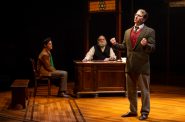Not-So-Super Man
The History of Invulnerability, the Rep’s new play about Superman’s creator, is a flashy but empty cartoon.
Over four years and some 50 productions as artistic director of Milwaukee’s most prestigious, best known and best funded theater, Mark Clements has often pushed his shows to the edge. He has fought for and won expanded production capabilities to encourage new works. He has dared to misfire if driven by larger artistic purpose. He has been tempted but never succumbed to letting improved technical expertise camouflage emptiness, while hiring the best available onstage and backstage talents.
But misfiring is a kind description for what has happened to the closing show of the Quadracci Powerhouse season, The History of Invulnerability, heavily promoted as an elaborately staged production that seeks the social truth behind the invention of Superman.
Playwright David Bar Katz is a theater person as experienced as Clements. Given the sterling reputations of those involved, the signs of impending disaster and the need to rewrite had to be visible early in the process. Yet in a subscription series where rehearsal time is of the essence the decision was made to double down on production flash to seduce the audience into accepting an illustrated lecture as a major piece of theater.
Siegel, concocting a hero who can do everything he can’t, invests all his dreams in creating the cartoon Man of Steel – only to see corporate injustice wipe away his name and recognition for his creation. So there is a fascinating 10 minute dinner table talk within the two and a half hours.

(L – R) Michael Kroeker, Bob Amaral, Greg Wood, Angela Iannone, and JJ Philips in Milwaukee Repertory Theater’s 2013/14 Quadracci Powerhouse production of The History of Invulnerability. Photo by Michael Brosilow.
Katz as semiologist and social commentator has created a polemic more than a play, and Clements has jumped both feet in with contrivance rather than interpretation, counting on our enduring fascination with action heroes to keep the game going – almost interminably.
The best touches of humor are dropped early – how it was no accident that Superman in muscular skintight costume and Lois Lane as an ideal body model consumed adolescents with sexual fantasies. But those observations are quickly replaced with extended connections to the Holocaust and how the accepting American Jews who created Superman were doppelgangers for the accepting Jews being persecuted by the Nazis.
In desperate attempts to keep the audience engaged, the cast is beaten, shot and gassed naked to emulate the victims in a Nazi crematorium while Siegel and Kal-El (Superman) debate father-son psychology, one in hospital gown, the other in full caped attire.

(L – R) JJ Philips and Bob Amaral in Milwaukee Repertory Theater’s 2013/14 Quadracci Powerhouse production of The History of Invulnerability. Photo by Michael Brosilow.
A lavish amount of production money and capable casting is wasted on what turns out to be a Classics Comics Illustrated view of 20th century pop culture, augmented by every trick in the Rep’s extensive technical arsenal.
Taking risks is a good thing, but there is more going on here — or rather less if you value the credentials of those involved. Even those who understand the attraction of the concept have to be distressed by the outcome. For those whose families survived the Third Reich and for those from other backgrounds and generations pursuing a genuine emotional and artistic insight into the times, this production ends up as an intellectual insult.
Dominique Paul Noth served for decades as film and drama critic, later senior editor for features at the Milwaukee Journal. You can find his blog here.
Review
-
‘L’Appartement’ Is a Mind-Bending Comedy
 Mar 25th, 2024 by Dominique Paul Noth
Mar 25th, 2024 by Dominique Paul Noth
-
Highlands Café Is Easy to Love
 Mar 15th, 2024 by Cari Taylor-Carlson
Mar 15th, 2024 by Cari Taylor-Carlson
-
‘The Mountaintop’ Offers Very Human Martin Luther King Jr.
 Mar 11th, 2024 by Dominique Paul Noth
Mar 11th, 2024 by Dominique Paul Noth
Theater
-
‘L’Appartement’ Is a Mind-Bending Comedy
 Mar 25th, 2024 by Dominique Paul Noth
Mar 25th, 2024 by Dominique Paul Noth
-
‘The Mountaintop’ Offers Very Human Martin Luther King Jr.
 Mar 11th, 2024 by Dominique Paul Noth
Mar 11th, 2024 by Dominique Paul Noth
-
‘The Chosen’ Is Subtly Powerful Drama
 Mar 10th, 2024 by Dominique Paul Noth
Mar 10th, 2024 by Dominique Paul Noth
















